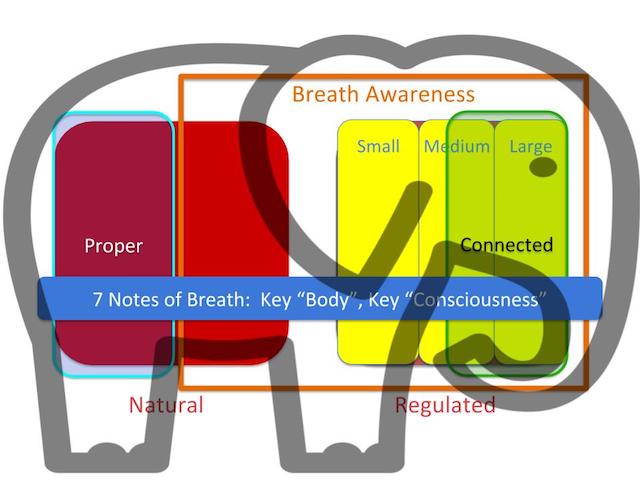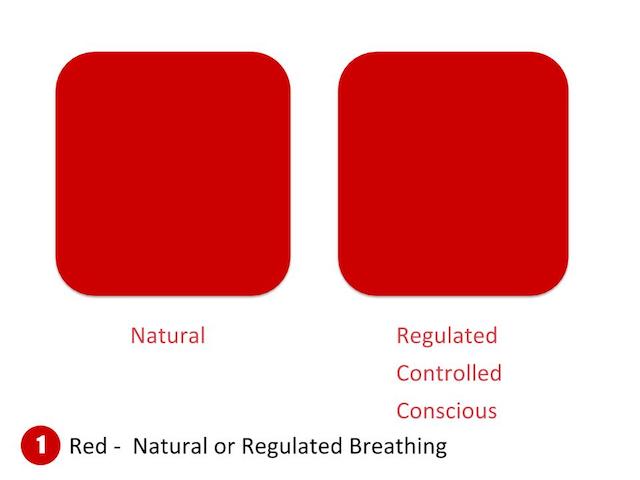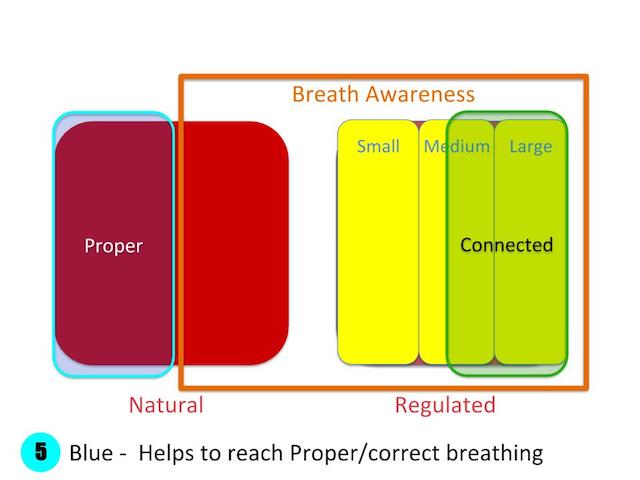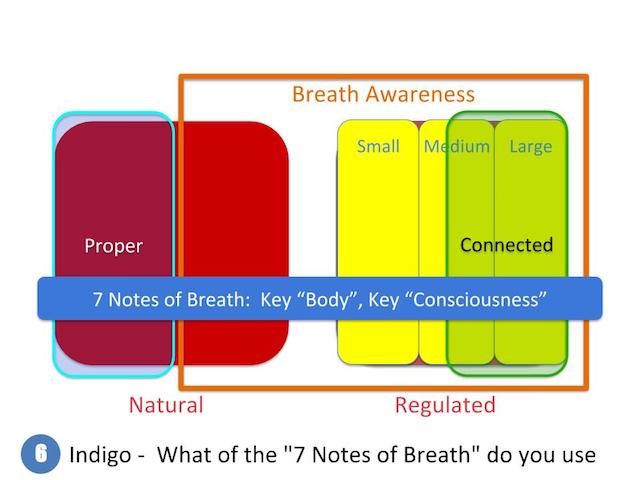
Rainbow Map of Breathwork
Breathwork schools and techniques classification
By Liubov Bogdanova

In the world where many breathwork styles and methods exist, it's easy to get lost.
It looks like there is no structure or a map in that field, where every school or technique could have its own place, and it will be clear how to distinguish them one from another.
We could forgive the customers if they have no clarity in these issues, however for the professionals it is important to know what you are doing, what place your technique takes in the whole spectrum of breathwork practices. Here are the questions both trainers and students might find confusing:
- How do you know, whether you need Rebirthing, Vivation, Transformational breath or something else? What practice is better? And how to compare them?
- Why Rebirthing or pranayama are taught one way by one trainer, but totally different by another? Whose version is correct?
- Can you trust large breathing sessions only, when the client is supposed to lie down on the floor and breathe for one hour or more, or maybe some small and medium practises might be useful too? What to choose?
- How to know if your breathing (or your customer’s one) is correct or not? Do you recognize healthy breathing patterns? If you spot unhealthy breathing habbits – would you be able to help?
- What to do, if you face many controversial instructions on safety, e.g. one trainer says that deep breathing for a long time is dangerous, another says it is necessary and beneficial, at the third one – it is up to you, you might breathe any way you like?
- You tell someone “I am a breathworker” - and they say “Do you mean pranayama? (Buteyko method? Rebirthing? Etc.) ” or maybe even “No, thank you, I am not interested in esoteric or mystic things”.
The breathwork trainers sometimes are not aware of what part of professional knowledge or skills they have, what they lack and what else they have to learn to grow professionaly.
So, many people, both clients and breathwork trainers are not sure about how much they know or do not know in the world of breathwork. We could illustrate this situation by a famous parable about partial knowledge – about blind people who met the elephant. One was touching a leg and said, it is like a tree. Second was touching his side and said it is like a wall. Third was touching a trunk and said it is like a snake.
After many years of my research in this field and study at quite a lot of breathwork schools I got some idea how to approach the comprehensive map of breathwork, where all the breathwork schools, methods and techniques find their proper place.
I hope this map will help us to balance magic of breath and an intuitive approach (which makes breathwork an art), with the clear comprehensive structure, practical set of skills and knowledge, that will add more science to our profession.
The purpose of this article is to provide you with the general classification of all the breathwork schools and methods and to encourage you to share your views on that matter.
Rainbow set of colours
Let’s look at the breath itself.
It is a multi-level phenomenon. We can not create one range of breathwork techniques and consider it done, because breathing has many attributes, which are being used in the practices.
That’s why I decided to use Rainbow colours, so we could talk about each and every attribute and not to confuse the layers.
While reading this article think of the breathwork technique you know or want to learn and find its place on this map.
1. RED
First of all we need to consider the uniqueness of breathing in a human body, as it is the only phenomenon with two modes: breathing can be either natural or regulated.

If we go beyond just practical understanding and address scientific relevance, we would need to consider also the terms «controlled» and «conscious» breathing. Maybe they are synonyms to the regulated mode. If yes – we need to remember that, if not – we need to clarify the difference between all these terms. To put it simple I suggest treating them as synonyms.
2. ORANGE
Shall we take a look at the difference between «conscious breathing» and «breath awareness»?
Can you breathe consciously without being aware of that? Can you practice breath awareness without breathing consciously?
I believe that every time you breathe consciously, control and regulate your breathing - you are aware of that. So breath awareness covers this red section of «Regulated /Controlled/Conscious breathing» for 100%.

What about natural breathing? You might practice breath awareness without regulating your breath. There are well known breathing practices such as:
- Anapana: observing the area at the entrance to your nostrils
- Buddhist breathing meditation: counting natural breaths
- Playing with the breath (by Dan Brulè): you observe the smallest details of your breathing.
However, natural breathing might also happen outside of your awareness - when natural breathing is at work, but our attention is not there, and we are not aware of our breathing – when sleeping or just going through our daily routine.
So I believe that breath awareness covers part of natural breathing section.
3. YELLOW
As we are here for working with breath - let’s look closely at regulated breathing area.
It seems to me that all the possible breathing exercises, practices and techniques can be divided into three groups: small, medium and large.

Small Breathing Practices are short breathing exercises consisting of one breathing cycle which take from 1-2 to 5-10 seconds. They are easy to carry out and deliver quick results. You can find a hundred reasons to do small breathing practices, and you can use them in any situation, in any posture (standing, sitting, lying, walking). You can do them alone or in public, without attracting any attention.
You probably wash your hands plenty of times every day as well as you wash up after drinking tea. So, you should be doing a lot of small breathing practices like that, every day to cleanse your body and mind.
Medium Breathing Practices are breathing exercises involving several breaths which take from 5-10 seconds to a few minutes. They can deliver remarkable results, like eliminating stress, becoming calm and peaceful if needed, or the opposite: energized and active.
The majority of breathing practices world golden collection belongs to this group:
Yoga, chi kung, famous Buteyko method,etc.
Of course you can use these practices in a class with your breathwork trainer, but you also can incorporate all of them into your daily life. Some of them could be done in public, some of them not – but you always find some discrete place and breathe more noisy or combine breathing with some small movements.
You can apply medium practices to reduce physical pain, get rid of irritation in a traffic jam or when your computer crashes! You can compare them to taking a bath or a shower or to house chores.
Large Breathing Practices
No matter how clean you keep your house in your daily life – even the best housekeepers need to do deep cleaning once or twice a year. Everyone understands that deep cleaning is something out of the ordinary.
These are large breathing practices - long and deep breathing sessions.
If you have no idea how to clean the cells and organs of your body, how to clear your emotions, your thoughts and your soul – then you need to master large breathing session.
There are about dozen techniques in this group:
Rebirthing-Breathwork, Vivation, Holotropic Breathwork, Sudarshan Kriya, some Osho meditations, Transformational Breath Sessions, some author techniques - Satori Breathing by Colin Tipping, Liberation breathing by Sondra Ray, in Russia we have “Free breathing», «Breathing - Music- Movement», «Cleansing of your energy structures” and so on.
Of course if you can do them more often than once or twice a year - that is even better! It will reinvigorate your body, your mind and your life.
Large breathing techniques have pretty much in common, but some things are different.
At the bottom of all large breathing techniques you will find the same idea - circular connected breathing. Usually the breathers enter some particular state of consciousness (and the name of this state needs to be clarified – is it «altered state of consciousness», «expanded state or consciousness», «state of higher awareness» or again they all are just synonyms?)
I believe that large breathing practices have tendency to merge. The practitioners use the common base - connected rhythm for quite a long time like 30 mins - 1 hour and more, and add some adjustments such as: playing music, touching the breather, saying some words aloud, talking to the breather, encouraging some movements or noises of the breather etc.
The world of large breathing practices might be subject to a special research and comprehension.
However, I would like to emphasize that if the breathwork trainers teach large breathing practices only, they miss the opportunity to equip their students with useful skills for their daily life and give them support between the sessions in a form of small and medium practices. Also small practices give better training for large breathing practices mastery because they are the elements you might use during large breathing sessions.
And if the breathwork trainers teach small and medium breathing practices only, they miss the opportunity to help their students with «deep cleaning» and give them one of the most unique and useful experiences.
4. GREEN
Now it is time to go green! Let's think of the connected breathing and energy.
Сonnected breathing is a special tuning to your breathing where there are no pauses between the inhales and exhales, so all your breathing cycles and their parts are connected with one another. This is the essence of energy breathing.
That is why I believe all of large breathing practices are based on a connected breathing rhythm – they engage energy flow.
Besides, there are quite a lot of medium breathing practices based on a connected rhythm, such as «20 connected breaths» by Leonard Orr, 'Energy shower' exercise , “4 by 4” exercise, Vim Hof breathing, some exercises for pregnant women, some exercises for increasing your money awareness, etc.

So green area will cover all the large breathing practices section and some part of medium breathing practices one.
Considering that we might rephrase the definition of breathwork at IBF website, where the breathwork is described as a practice using connected breathing techniques only.
5. BLUE
Next step brings us to the issue of proper or correct breathing, which means having a healthy pattern of natural breathing.

There are some breathing techniques which help to realize whether your natural breathing is healthy, and if not, they would allow you to correct dysfunctional breathing patterns.
6. INDIGO
In order to do so you need to understand what exactly to look for in your breathing, and what exactly to work with.

7 notes of breath will help us to achieve that and even more. They are 7 breath parameters:
- which you might monitor and test in order to understand if your natural breathing is correct in the blue area.
- which you could observe during your practice of breath awareness in the rest of natural breathing area.
- which you apply in a yellow area in a form of small, medium and large breathing practices.
More detailes about 7 notes of breath here: 7-notes.html
7. VIOLET
According to the rainbow still there is a space for a violet colour, so let me hope that you can continue completing this map and indicate new areas.
We might also classify breathwork techniques by many other attributes, such as:
- time of origin
- nationality of the author
- profession of the author
- recognition by some social institutions: national healthcare system, psychological scientific community, main world religions, state authorities etc.
- pre-requirements to the trainers (medical, psychological or other background)
- if you need to complete specific program, learn some set of skills and knowledge before you start working with the clients
- time you need to reach the goal
- possibility to reach specific goal
- possibility to practice without a trainer or sitter
- etc.
If we want to classify breathwork techniques by activating or calming down effect – we need to look more closely into 7 breath parameters. It is not the technique, which causes such an effect – some elements of the technique do so, some particular breathwork parameters. That is why we might use the same technique (e.g. 20 connected breaths) and get opposite results – either activating or relaxing.
To sum up: here is the list of breathwork technique categorization by various aspects:
RED: Do you work with natural or regulated breathing?
ORANGE: Do you apply breath awareness or not?
YELLOW: Do you practise or teach small, medium or large breathing practices?
GREEN: Do you use connected breathing rhythm?
BLUE: Does your practice help to reach «proper breathing» i.e. to develop healthy patterns of natural breathing
INDIGO: What breath parameters do you use and regulate through the key «Body» and key «Consciousness».
Now let's give a hug to a whole elephant :)

Here is the list of advantages of this map:
- You can see the place of your technique, that you have been practicing and/or teaching, in the whole spectrum of breathwork practices.
- You can provide your clientele with more comprehensive description of your work by telling them about each «rainbow colour».
- You got some ideas what questions to ask when you come across new breathwork method or technique.
- You can see how to compare your technique with other ones, even if you have not learned them at the professional level.
- You can see what is left to learn for your further growth at a personal and professional level.
About the author:

Liubov Bogdanova
Founder and managing director of International Center of Conscious Breathing Studying and Practicing, Moscow, Russia
- Passionate promoter of conscious breathing in Russia and Russian internet
- Breathwork practitioner with 25 year experience in personal practice and 17 year experience in teaching groups and individuals
- Has carried out exnended practice and traveled with Dan Brule - world-renown teacher of breathmastery
- Studied many breathwork techniques at the schools of Rebirhthing breathwork, Free breathing, Spiritual breathing, Vivation, Pranic nourishment, Chi Kung, Art of Living, Yoga in Dance, Tantra, Russian author techniques.
- Author of more than 30 training programs for the beginners, advanced students and practitioners.
- Author of the book “Conscious breathing – Key to your life. Simple breathing exercises for health in body, emotions, mind and spirit”
- Frequent local and national television guest
- Organizer of International Russian Forum of Conscious Breathing in cooperation with IBF
+7 903 117 36 63
© 2017-2018, Liubov Bogdanova
Read more: 7 Notes of Breath. Systematic Approach to the Breathwork.